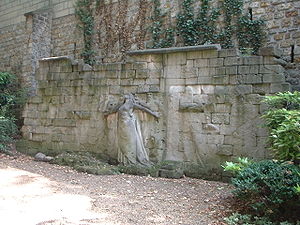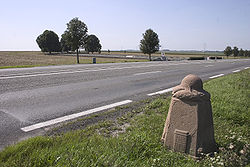
Paul Moreau-Vauthier
Encyclopedia

France
The French Republic , The French Republic , The French Republic , (commonly known as France , is a unitary semi-presidential republic in Western Europe with several overseas territories and islands located on other continents and in the Indian, Pacific, and Atlantic oceans. Metropolitan France...
sculptor.
Moreau-Vauthier first achieved public renown with his statue La Parisienne shown at the Exposition Universelle (1900)
Exposition Universelle (1900)
The Exposition Universelle of 1900 was a world's fair held in Paris, France, from April 15 to November 12, 1900, to celebrate the achievements of the past century and to accelerate development into the next...
in Paris
Paris
Paris is the capital and largest city in France, situated on the river Seine, in northern France, at the heart of the Île-de-France region...
, and is now perhaps best known for his memorial wall to the Victimes des révolutions (Mur des Fédérés) on Avenue Gambetta, Paris. He also created an allegorical work to commemorate Louis Blériot
Louis Blériot
Louis Charles Joseph Blériot was a French aviator, inventor and engineer. In 1909 he completed the first flight across a large body of water in a heavier-than-air craft, when he crossed the English Channel. For this achievement, he received a prize of £1,000...
's first cross-Channel airplane flight in 1909.
A veteran of the Battle of Verdun
Battle of Verdun
The Battle of Verdun was one of the major battles during the First World War on the Western Front. It was fought between the German and French armies, from 21 February – 18 December 1916, on hilly terrain north of the city of Verdun-sur-Meuse in north-eastern France...
, Moreau-Vauthier had the idea in 1920 to memorialize World War I by installing a series of sculpted stones along the 650 km front from Nieuwpoort, Belgium
Nieuwpoort, Belgium
Nieuwpoort is a municipality located in Flanders, one of the three regions of Belgium, and in the Flemish province of West Flanders. The municipality comprises the city of Nieuwpoort proper and the towns of Ramskapelle and Sint-Joris. On January 1, 2008 Nieuwpoort had a total population of 11,062....
through Moosch
Moosch
Moosch is a commune in the Haut-Rhin department in Alsace in north-eastern France.-References:*...
near Altkirch
Altkirch
-See also:* Château d'Altkirch - destroyed castle in the town.* Communes of the Haut-Rhin department-References:* -External links :* * * * * * * *...
, and on to the Franco-Swiss border. He presented his first model that year in Paris; Henri Defert, president of the Touring Club of France, endorsed the idea and invited the Belgian Touring Club to join the project. A total of 240 markers were planned (28 in Belgium, 212 in France), of which 118 were erected (22 in Belgium, 96 in France) in the years between 1921–1927. Three basic designs differ primarily in the helmet
Helmet
A helmet is a form of protective gear worn on the head to protect it from injuries.Ceremonial or symbolic helmets without protective function are sometimes used. The oldest known use of helmets was by Assyrian soldiers in 900BC, who wore thick leather or bronze helmets to protect the head from...
capping the milestone (French, Belgium, British), with side decorations of infantryman's gear such as water bottles, hand grenade
Hand grenade
A hand grenade is any small bomb that can be thrown by hand. Hand grenades are classified into three categories, explosive grenades, chemical and gas grenades. Explosive grenades are the most commonly used in modern warfare, and are designed to detonate after impact or after a set amount of time...
s, etc. Many of these Borne du Front stones are still extant. See image below.
Moreau-Vauthier died in 1936 in a car accident at Ruffigny near Niort
Niort
Niort is a commune in the Deux-Sèvres department in western France.The Latin name of the city was Novioritum.The population of Niort is 60,486 and more than 137,000 people live in the urban area....
in Deux-Sèvres
Deux-Sèvres
Deux-Sèvres is a French département. Deux-Sèvres literally means "two Sèvres": the Sèvre Nantaise and the Sèvre Niortaise are two rivers which have their sources in the department.-History:...
, and is buried in Père Lachaise Cemetery
Père Lachaise Cemetery
Père Lachaise Cemetery is the largest cemetery in the city of Paris, France , though there are larger cemeteries in the city's suburbs.Père Lachaise is in the 20th arrondissement, and is reputed to be the world's most-visited cemetery, attracting hundreds of thousands of visitors annually to the...
in Paris.

Selected works
- La Parisienne, Paris, Exposition Universelle (1900)Exposition Universelle (1900)The Exposition Universelle of 1900 was a world's fair held in Paris, France, from April 15 to November 12, 1900, to celebrate the achievements of the past century and to accelerate development into the next...
- Victimes des révolutions, Avenue Gambetta, Paris; designed 1900, built 1909
- Borne du Front, many locations; between 1921–1927
- The monument commemorating those black soldiers from Africa who had served France in the Great War- “ Aux héros de l’Armée noire”. Two identical bronze statues were made. One was erected in Bamako in West Africa in what was then the French Sudan but is now Mali and the other in Reims chosen especially as Senegalese troops had played a major role in her defence from May to July 1918. Moreau-Vauthier’s work involved four black soldiers grouped around a white officer, all defending the national flag. The bronze sculpture stood on a granite pedestal and on the four sides of this pedestal the names were inscribed of those battles in which black troops had fought-YSER/ARRAS/DARDANELLES/SOMME/VERDUN/ALSACE/CHEMIN DES DAMES/CHAMPAGNE/REIMS/CHATEAU-THIERRY/AISNE/ORIENT/MAROC/CAMEROUN-TOGO. The Reims monument was destroyed by the Germans during their occupation of Reims during the 1939-1945 war;its sentiments in honouring negroes being anathema to the Nazi code. The monument also carried the inscription « Aux héros de l’Armée noire » : « en témoignage de reconnaissance envers les Enfants d’adoption de la France, morts en combattant pour la Liberté et la Civilisation » The monument in Reims was replaced after the Second World War and a new memorial can now be seen.

